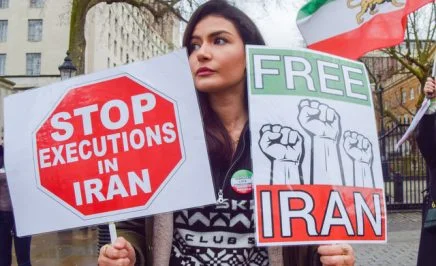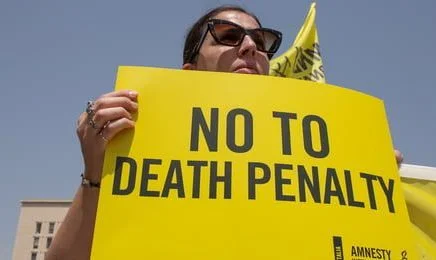In the run up to the release of our death penalty report for 2014, Amnesty International Intern Samantha Bartlett dispels 10 myths surrounding executions worldwide.
Myth 1: Only evil people who have committed horrific crimes are executed
FACT: The death penalty applies to a number of different crimes worldwide, not all of which are horrific. In many countries, such as Iran and Sudan, authorities execute their political opponents. In North Korea, citizens have been publicly executed for communicating with individuals outside of their country.
Regardless of the crime committed, there is more to an individual than their worst offence. Many of the prisoners on death row in the US suffered horrific abuses prior to committing violent crimes; and are a product of their environments.
Research has also consistently shown that individuals are capable of change. Following the 1972 United States Supreme Court decision that the arbitrary application of the death penalty constituted cruel and unusual punishment, 322 death-row prisoners were released. Only 5 of those 322 prisoners murdered again. The vast majority were capable of rehabilitation; and most were incredibly remorseful for their crimes.
These figures strongly suggest the majority of individuals who commit violent crimes are not ‘evil’. It is also evidence that permanent incarceration is suitable punishment for violent crimes, rather than execution.
Myth 2: Only people who are truly guilty receive the death penalty
FACT: No justice system is free from error; and not all individuals who are sentenced to the death penalty are guilty of the crimes for which they have been convicted.
Since 1973, 144 death row prisoners have been exonerated in the US alone. As long as criminal justice systems remain fallible, there is a possibility of executing innocent people.
Myth 3: Death penalty trials are a fair process
FACT: Around the world, many people are still executed after grossly unfair trials and/or after being subjected to torture. The top three executing countries – Iraq, Iran and China – all issue death sentences in unclear circumstances.
In Pakistan, Shafqat Hussain was executed after ‘confessing’ to kidnapping and involuntary manslaughter after nine days of torture. He was arrested at the age of 14.
Myth 4: The death penalty applies to all individuals equally
FACT: People who are convicted of the same crimes are often given different sentences, both across the world and in the same country. Research has consistently shown that individuals are more likely to be given the death penalty if they are poor or belong to a racial, ethnic or religious minority. The reason for this is two-fold: individuals from poorer, marginalised groups have less access to the resources needed to defend themselves; and there is inherent discrimination present in the justice system.
Myth 5: Executions are humane
FACT: All types of execution risk causing the victim extreme pain. This is especially the case for execution by hanging, shooting, stoning and beheading. Even lethal injections, which are meant to be the most humane form of execution, still risk incredible pain, especially if the part of the injection process meant to knock the prisoner out is botched.
Myth 6: The death penalty is an effective deterrent to violent crimes
FACT: There is no convincing evidence that the death penalty is an effective deterrent to crime. Many murders take place when the perpetrators are under great emotional stress, or under the influence of drugs – times when they are not considering the consequences.
Research has consistently shown that the death penalty does not deter crime more effectively than other punishments.
A 1988 United Nations research report found:
“…it is not prudent to accept the hypothesis that capital punishment deters murder to a marginally greater extent than does the threat and application of the supposedly lesser punishment of life imprisonment”.
In Canada, the homicide rate actually fell by 40 per cent in the three decades following 1975, the year before the death penalty for murder was abolished. Research from other countries has failed to show that repealing the death penalty causes an increase in crime rates.
The use of the death penalty cannot be credited with making societies any safer.
Myth 7: The death penalty effectively prevents terrorist attacks
FACT: Individuals who are willing to kill or injure others for the sake of a cause or ideology are unlikely to be deterred by the prospect of execution. In fact, counter-terrorism officials have often pointed out that individuals who are executed may be perceived as martyrs, whose memory may become a rallying point for ideology or organisations. Armed opposition groups have also used the death penalty as justification for retaliation, thereby continuing the cycle of violence.
Myth 8: Execution is cheaper than imprisonment
FACT: At least in the US, enforcing the death penalty is more expensive than imprisoning individuals for life. The judicial process is much longer and more complicated. The California Commission on the Fair Administration of Justice estimated that, in California, death penalty trials cost approximately $1.1 million more than the average murder trial. The Commission estimated that the death penalty system cost California approximately $125 million more per year than the cost of permanent incarceration. This money could be diverted towards early prevention and intervention strategies, which would prevent crimes punishable by the death penalty from occurring and reduce the number of people on death row.
Myth 9: The death penalty offers justice and closure to the victims’ families
FACT: Not all victims’ families are in favour of the death penalty. The international movement against the death penalty involves many individuals who have lost loved ones to violent crime, but for ethical or religious reasons are not in favour of the death penalty. The New Hampshire-based organisation Murder Victims’ Families for Human Rights is helping lead the movement to abolish the death penalty in the US.
Myth 10: The death penalty is fine as long as the majority of the public supports it
FACT: History presents us with numerous examples of human rights abuses supported by the majority at the time – prominently including slavery, lynching and racial segregation. The death penalty is a violation of the right to life, as enshrined in the United Nations Declaration of Human Rights. It is also cruel, inhuman and degrading.
Amnesty opposes the death penalty at all times; regardless of who is accused, the crime, guilt or innocence or method of execution. Even if the majority of the public supports the death penalty, it should not be treated as an acceptable form of punishment under any circumstance.








